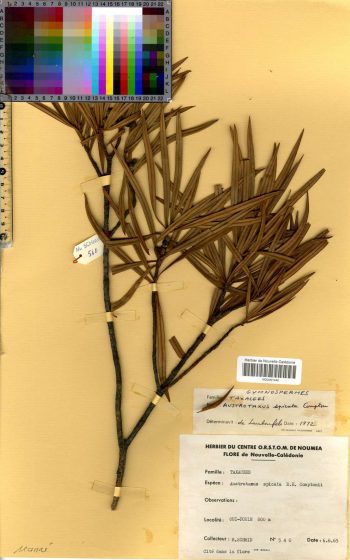
Austrotaxus, as described in 1922 by Robert Harold Compton (1886-1979) in Journal of the Linnean Society, Botany 45th edition, is commonly known as New Caledonia yew or Southern yew (Latin translation). It is a monospecific genus of conifer, related to the yews. However, its classification has been disputed in the past, with some suggestions that it may be best placed in its own family the Austrotaxaceae or be related to the Podocarpaceae, but recent genetic evidence places it firmly in the Taxaceae, related to the other yews in the genera Taxus and Pseudotaxus.
Description. New Caledonia yew is an evergreen coniferous shrub or small tree that grows to mature heights of 15 to 65 feet (5-20 m) (rarely to 80 feet / 25 m) tall with reddish bark. The leaves are lanceolate and flat, measuring 3.2 to 5 inches (8 - 12 cm) long (up to 7 inches / 17 cm long on young plants) and 0.16 inch (4 mm) broad, colored dark green above, with two paler green stomatal bands below; they are arranged spirally on the stem.
This genus is dioecious with male and female fruiting bodies growing on separate trees. Seed cones are drupe-like, measuring 0.8 to 1 inch (20 - 25 mm) long, with a fleshy aril almost completely surrounding the single seed, but with the tip of the seed exposed. The pollen cones measure 0.4 to 0.6 inch (10 - 15 mm) long and slender.
The markedly longer leaves and large seeds readily distinguish it from the yews in the genus Taxus. In appearance, it most closely resembles Catkin-yew (Amentotaxus spp.), but it is actually closely related to yew (Taxus) and white-cup yew (Pseudotaxus). All three of these genera lack resin canals in the leaves, an unusual feature for conifers, but Austrotaxus differs from Taxus and Pseudotaxus in its larger leaves and seeds, with a thinner, tight-fitting aril and its spiky pollen cones (actually more similar to Amentotaxus).
Distribution. Austrotaxus is the only genus of Taxaceae found in the southern hemisphere. This genus is endemic to New Caledonia, occurring in the central and northern parts of the island on serpentine soils growing at elevations of 1,000 to 4,000 feet (300-1,350 m) over sea level. As a tropical conifer, it is hardy to only USDA Zone 10, cold hardiness limit between 30º and 40ºF (-1° and +4.4°C).
This conifer is not in general cultivation, likely existing only in a few tropical arboretums or conservatories. There are also no known named cultivars.